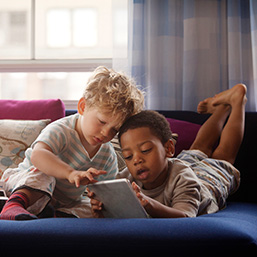
There is abundant research on the importance and value of positive relationships in overall health and well-being. Sharing is a significant part of relationship development and human growth. Sharing is not only a key aspect in the development of social-emotional skills but it influences cognitive development as well.
As with other developmental milestones, there is a timeframe when you might expect your child to begin learning to share. Between three to four years of age is when the child typically begins to show readiness. Younger children are egocentric and not ready for this complex dance of give and take.
In the three- to four-year age range, children are speaking more, asking questions, and are more attentive to the world outside of themselves. Children are moving from parallel to more cooperative play. When a child has a sense of their feelings and sees that others have feelings too, then they are ready to begin learning about sharing.
Sharing teaches about fairness, communication, compromise, and cooperation. In the context of their social-emotional development, the child’s cognitive development is enhanced through perspective-taking, flexibility, and creative thinking. Using language like “taking turns” helps children learn that they will also get a turn and something is not gone forever.
But is sharing okay for everything? Here are some guidelines to consider.
There are lots of instances when it’s okay to ask a child to share.
When playing with others. When playing a game or with toys in a group, sharing is encouraged.
Everyone gets a turn, and fairness and cooperation are prompted. Sharing in group play also teaches patience and impulse control.
When there are limited resources. The playground only has so many swings and other equipment. There are often limited toys, crayons, building blocks, and other things. Sharing resources promotes flexibility, cooperation, and communication skills.
Generosity and care for others. When a child doesn’t have a toy or is playing alone, including the child by offering to share teaches perspective-taking and empathy.
There are also times when it’s okay not to share.
Special things. When a child has something very important and special to them (a toy, blanket, or stuffy), it’s okay not to share. Putting the object away when other children are around is the best way to manage this. Respecting the child’s emotional and personal connection to things is important for developing autonomy and boundaries.
When they're not ready. Keeping the developmental timeframe in mind is important when considering if a child is ready. Young children who do not have a sense of self and their feelings are not yet at the point where they are ready to take on this more complex skill. Children develop at individual paces and it’s important to monitor your child’s readiness.
Setting boundaries. Teaching children that it's okay to say "no" when they don’t feel comfortable sharing helps them develop a sense of personal boundaries, as well as respect for others' boundaries.
Sharing is a complex social-emotional skill that takes time to develop and grow. It’s important to remember that children are experiencing intense growth and are learning many different things simultaneously. Any skill takes time to develop. Modeling good sharing behavior at home and within the family will make it easier for your child to learn this important skill. Be patient and supportive. Understanding the developmental goals and timing to consider helps parents support their child to positively connect with others, which will support their long-term health and well-being.
Nicole is a registered psychologist in the province of Alberta. She has worked with children and families for over 30 years in various capacities. Nicole holds a permanent teaching certificate and has an understanding of classroom functioning. Nicole is passionate about supporting children and families in achieving success and dignity through assessment, intervention, and collaborative approaches.
See our relate articles:
Calgary’s Child Magazine © 2024 Calgary’s Child